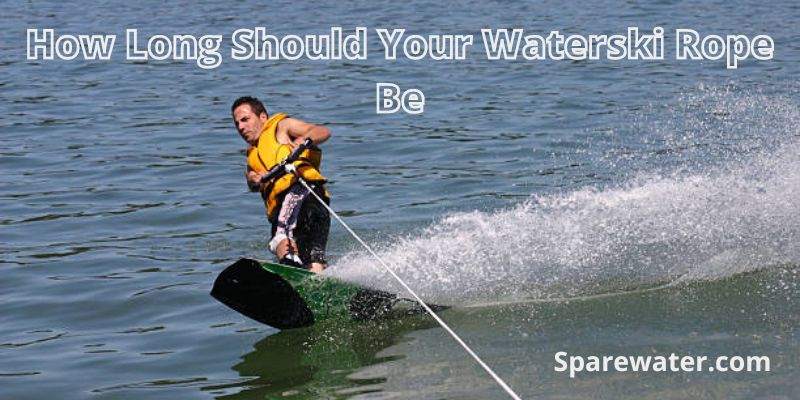When it comes to waterskiing, the length of your ropes makes all the difference. Too short and you won’t have enough slack for turns or jumps; too long and you risk losing control.
Knowing how to properly measure your rope will help ensure a safe and fun experience on the water.
We’ll discuss how to determine the ideal rope size for waterskiing as well as factors that can influence your decision.
Let’s get started.
How Long Should Your Waterski Rope Be
The most common lengths range from 55 feet (17 meters) to 75 feet (23 meters). Generally speaking, if you’re a beginner skier, going with a shorter rope is best, typically between 55-65 feet (17-20 meters).
This length allows for more control and a slower speed. More advanced skiers tend to go with longer ropes, between 65-75 feet (20-23 meters). Longer ropes allow for greater speed and more distance between the boat and the skier.
In addition to skill level, other factors can influence your rope selection such as body weight, wind conditions, water temperature, and type of ski used.
Heavier skiers need extra slack to have enough time to make their turns while lighter bodies require less. Windy days also require shorter ropes since they are less likely to blow away from the boat.
Likewise, cold water requires shorter lengths due to decreased buoyancy. Lastly, different types of skis, slalom, trick, and jump, all require different lengths of ropes.
Choosing the right waterski rope length doesn’t have to be a tricky process. With a bit of preparation and knowledge of factors such as skill level, body weight, and water conditions, you’ll be able to find the perfect size for an enjoyable experience out on the water.
So make sure to take into account all the important elements before selecting your waterski rope size.
Factors To Consider When Choosing The Length Of Your Waterski Rope
The length of your waterski rope is an important consideration when you’re hitting the water. It affects not only how you ski, but also your safety while skiing.
Here are some factors to consider when choosing the right length for your waterski rope:
Skier’s Experience Level
If you’re a beginner, you should opt for a shorter rope to help control speed and keep your skis closer to the boat.
As you gain more experience, you can gradually increase the length of your rope for greater speed and distance behind the boat.
Skier’s Weight And Height
Heavier or taller skiers need longer ropes to be able to get up on their skis easier and maintain control.
Boat Speed
The faster the boat goes, the longer the rope should be.
A shorter rope will cause you to drag behind the boat and could be dangerous if you’re going at high speeds. Longer ropes allow you to enjoy all the thrills of waterskiing, even when on a fast boat.
Water Conditions
In choppy water or waves, it’s best to use a short rope.
This will give you more control over your skis and make it easier for a spotter to help keep you upright if necessary. In calm waters, go for a longer rope to get maximum enjoyment from your time on the water.
Choosing the right length of your waterski rope is important. Consider your experience level, your weight and height, the speed of the boat, and water conditions when making your decision for maximum safety and enjoyment.
Importance Of Selecting The Right Length For Your Waterski Rope
It is important to select the right length of your waterski rope for several reasons. If you choose a rope that is too long, it can make it more difficult to control the direction and speed of your skiing.
Additionally, if the rope is too short, you will not be able to ski at speeds that are comfortable and safe for you.
It’s essential to find a balance between having enough line tension so that you have better control over turns and tricks while avoiding too much tension which could cause fatigue or even injury.
In addition, when selecting a waterski rope, it’s important to consider the various elements that can influence your rope length.
These include your weight, skill level, and water conditions. For example, heavier skiers may benefit from a longer ski rope as it requires less force to pull them out of the water.
On the other hand, experienced skiers often opt for shorter ropes to have more control over their turns and tricks.
Furthermore, if you’re skiing in choppy waters or high winds, you will want a longer line so that you maintain greater stability during your rides.
Ultimately, selecting the right length for your waterski rope is essential for safety and performance on the water.
Be sure to take into account all relevant factors before making your decision to maximize fun and minimize risk.
Conclusion
Choosing the right length of your waterski rope is essential to ensure an enjoyable and safe experience out on the water.
Consider your skill level, weight, and height, as well as boat speed and water conditions when selecting the appropriate length for your waterski rope.
Longer ropes are beneficial for heavier skiers and that skiing in choppy or windy conditions. Shorter ropes work better for more experienced skiers who need greater control over their turns and tricks.
With a little bit of planning beforehand, you can rest assured that you will be ready to hit the water with just the right size waterski rope.
